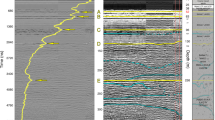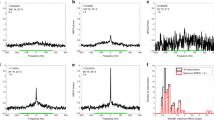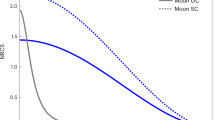Long-wavelength measurements reveal a paucity of ice in the Moon's polar craters.
Abstract
We have used a radio telescope at Arecibo Observatory, Puerto Rico, to map features of the lunar poles — some as small as 300 metres across — by collecting long-wavelength radar images that can penetrate several metres of lunar dust. We find that areas of the crater floors at the poles that are in permanent shadow from the Sun, which are potential cold traps for water or other volatiles, do not give rise to strong radar echoes like those associated with thick ice deposits in the polar craters on Mercury. Any lunar ice present within regions visible to the Arecibo radar must therefore be in the form of distributed grains or thin layers.
This is a preview of subscription content, access via your institution
Access options
Subscribe to this journal
Receive 51 print issues and online access
$199.00 per year
only $3.90 per issue
Buy this article
- Purchase on Springer Link
- Instant access to full article PDF
Prices may be subject to local taxes which are calculated during checkout

Similar content being viewed by others
References
Margot, J. L., Campbell, D. B., Jurgens, R. F. & Slade, M. A. Science 284, 1658–1660 (1999).
Bussey, D. B. J., Spudis, P. D. & Robinson, M. S. Geophys. Res. Lett. 26, 1187–1190 (1999).
Nozette, S. et al. Science 274, 1495–1497 (1996).
Nozette, S. et al. J. Geophys. Res. 106, 23253–23266 (2001).
Feldman, W. C. et al. J. Geophys. Res. 106, 23232–23252 (2001).
Black, G. J., Campbell, D. B. & Nicholson, P. D. Icarus 151, 167–180 (2001).
Harmon, J. K. et al. Nature 369, 213–215 (1994).
Black, G. J., Campbell, D. B. & Harmon, J. K. Lunar Planet Sci. Conf. XXXIII abstr. 1946 (2002).
Stacy, N. J. S., Campbell, D. B. & Ford, P. G. Science 276, 1527–1530 (1997).
Author information
Authors and Affiliations
Corresponding author
Ethics declarations
Competing interests
The authors declare no competing financial interests.
Rights and permissions
About this article
Cite this article
Campbell, B., Campbell, D., Chandler, J. et al. Radar imaging of the lunar poles. Nature 426, 137–138 (2003). https://doi.org/10.1038/426137a
Issue Date:
DOI: https://doi.org/10.1038/426137a
This article is cited by
-
Water Group Exospheres and Surface Interactions on the Moon, Mercury, and Ceres
Space Science Reviews (2021)
-
An Overview of the Lunar Crater Observation and Sensing Satellite (LCROSS)
Space Science Reviews (2012)
-
MESSENGER and the Chemistry of Mercury’s Surface
Space Science Reviews (2007)
Comments
By submitting a comment you agree to abide by our Terms and Community Guidelines. If you find something abusive or that does not comply with our terms or guidelines please flag it as inappropriate.



